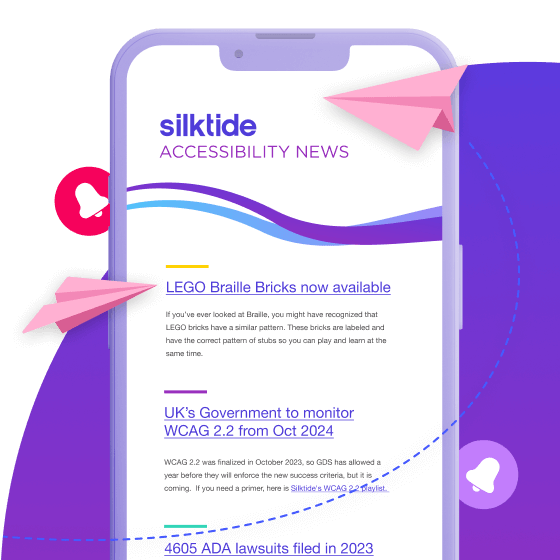More and more businesses are being sued under the ADA. Here are some steps you can take to minimize the risk of being one of them.
Online business is huge. In the US, there are around 1.7 million active websites in the retail sector alone. Over the past few years, there has been an onslaught of litigation under Title III of the Americans with Disabilities Act (ADA).
This results from users with a variety of disabilities challenging the accessibility of companies’ websites.
Lawsuits filed under the ADA have more than quadrupled in the past seven years.
The Beckage Website Accessibility Team, a US-based law firm with offices in New York, California, and Pennsylvania and made up of lawyers who are also web developers and web design business owners, continues to monitor federal filings under the ADA.
They’ve witnessed a growing trend of lawsuits being filed at record numbers, many of which target the retail and restaurant sector.
Put simply, more individuals with disabilities are using websites to access goods and services. This creates a higher risk to those industries and websites with accessibility issues.
So, how can your team avoid this risk? We’d recommend a three-step strategy:
- Arm yourself with knowledge of the legal risks;
- Understand the guiding requirements of the ADA; and
- Implement a proactive accessibility plan within your organization.
What the law means for you
So, what does “compliance” under Title III of the ADA look like for online businesses?
It’s not as straightforward as it should be.
In the US, the Department of Justice (DOJ) is responsible for ADA enforcement. Unfortunately, it has yet to take a formal position on the issue of website accessibility.
That being said, the Web Content Accessibility Guidelines (WCAG) 2.1, promoted by the W3C, have become widely accepted as a standard in web accessibility measurement.
These guidelines are often cited by courts as well as consent decrees and settlement agreements.
An example is the EU Web Accessibility Directive, which came into effect in September 2020 and the European Accessibility Act which came into effect in 2025.
The main issue in the US is that there’s no ‘official’ web accessibility framework that your business can work towards.
For this reason, a high number of these cases are settled outside of court, fairly quickly after they are filed, to avoid the expense of litigating in such uncertain terrain.
A typical accessibility claim
Most accessibility claims have similar allegations; a disabled individual argues that they encountered multiple access barriers that denied him/her full and equal access to the goods and services offered online by companies.
In most of these cases, the plaintiff has attempted to use their screen-reader to access the website and claims incompatibility with various parts of the website.
Other claims commonly made in these lawsuits include:
- Improperly labeled links and pages
- Inconsistent placement of on-page elements, like the shopping cart
- Lack of image alt-text
- Missing title elements
- Poorly-coded web forms
- Other features that help blind users navigate a website
Any of these are sufficient to risk a claim under the ADA. The list is not exhaustive.
Don’t overlays help prevent litigation?
In response to the growing trend of litigation, many businesses are looking for a quick and affordable remedy to address accessibility.
As a result, there’s been an explosion of vendors and tools, such as overlays and widgets, that supposedly assist businesses with achieving ADA compliance.
Overlays and widgets are simply applications and coding that sit between your website and assistive technology (such as screen readers).
The appeal of overlays and widgets are obvious.
However, overlays don’t work.
Overlays do not modify the underlying website code. This is important, because their main selling point is also the main reason not to use them.
You haven’t fixed the issue, you’ve simply masked it. Or at least, tried to.
So far, we have seen companies continue to be sued despite investing in widgets and overlays to address accessibility.
Practical Steps for Businesses
So what’s the best way to help your business become accessible?
Drawing from experience in handling a huge volume of settlement agreements and cases, Beckage recommends the following approach:
- Speak to experienced legal tech counsel familiar with this space as well as industry best practices;
- Ask them to evaluate the risk of litigation and regulatory compliance;
- Audit your website against WCAG 2.2 standards. Combine automated accessibility testing (to get the most coverage) and manual testing (for a high-quality but smaller sample of pages using assistive technology);
- Publish a legally-reviewed Accessibility Statement on your website; and
- Develop internal policies, procedures, and regular training that accessibility standards across your organization.
What is the goal of accessibility?
Making your website accessible to everyone is a moral obligation as much as a legal one. It also makes business sense.
Limiting your online store or website to a subset of your audience makes little sense. From a purely marketing and user-experience point of view, you need to attract visitors to your site and keep them there for as long as possible.
More time on your site means more sales.
If you don’t provide a great online experience (and accessibility is a large part of this) then you’ll simply lose customers to your competitors who are.
Accessibility doesn’t need to be difficult, nor an afterthought. With software like Silktide, which is filled with educational materials and step-by-step guides, even non-experts can understand accessibility.
Working with experienced counsel in this space such as Beckage, a law firm made up of former developers and web technologists, you’ll be able to navigate the uncertain legal landscape surrounding web accessibility, whatever your industry.
*Attorney Advertising. Prior results do not guarantee future outcomes.
Thanks to attorney Kara Hilburger, Esq. from Beckage for her contributions to this article.

